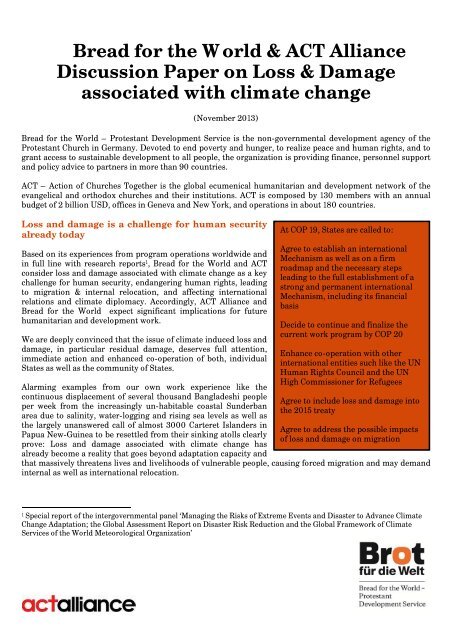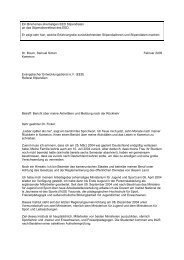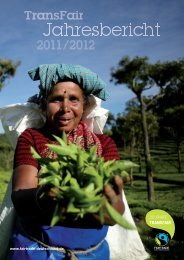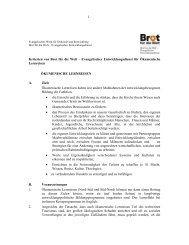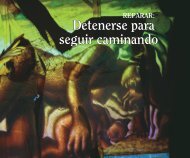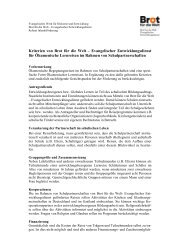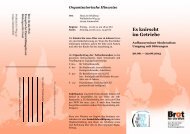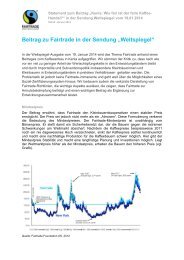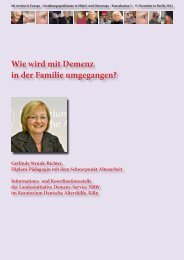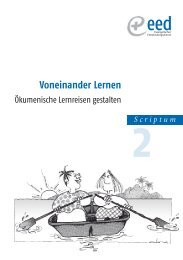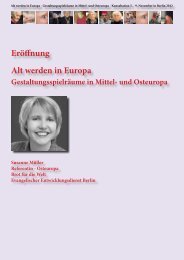Bread for the World & ACT Alliance Discussion ... - Brot für die Welt
Bread for the World & ACT Alliance Discussion ... - Brot für die Welt
Bread for the World & ACT Alliance Discussion ... - Brot für die Welt
- No tags were found...
Create successful ePaper yourself
Turn your PDF publications into a flip-book with our unique Google optimized e-Paper software.
<strong>Bread</strong> <strong>for</strong> <strong>the</strong> <strong>World</strong> & <strong>ACT</strong> <strong>Alliance</strong><br />
<strong>Discussion</strong> Paper on Loss & Damage<br />
associated with climate change<br />
(November 2013)<br />
<strong>Bread</strong> <strong>for</strong> <strong>the</strong> <strong>World</strong> – Protestant Development Service is <strong>the</strong> non-governmental development agency of <strong>the</strong><br />
Protestant Church in Germany. Devoted to end poverty and hunger, to realize peace and human rights, and to<br />
grant access to sustainable development to all people, <strong>the</strong> organization is providing finance, personnel support<br />
and policy advice to partners in more than 90 countries.<br />
<strong>ACT</strong> – Action of Churches Toge<strong>the</strong>r is <strong>the</strong> global ecumenical humanitarian and development network of <strong>the</strong><br />
evangelical and orthodox churches and <strong>the</strong>ir institutions. <strong>ACT</strong> is composed by 130 members with an annual<br />
budget of 2 billion USD, offices in Geneva and New York, and operations in about 180 countries.<br />
Loss and damage is a challenge <strong>for</strong> human security<br />
already today<br />
Based on its experiences from program operations worldwide and<br />
in full line with research reports 1 , <strong>Bread</strong> <strong>for</strong> <strong>the</strong> <strong>World</strong> and <strong>ACT</strong><br />
consider loss and damage associated with climate change as a key<br />
challenge <strong>for</strong> human security, endangering human rights, leading<br />
to migration & internal relocation, and affecting international<br />
relations and climate diplomacy. Accordingly, <strong>ACT</strong> <strong>Alliance</strong> and<br />
<strong>Bread</strong> <strong>for</strong> <strong>the</strong> <strong>World</strong> expect significant implications <strong>for</strong> future<br />
humanitarian and development work.<br />
We are deeply convinced that <strong>the</strong> issue of climate induced loss and<br />
damage, in particular residual damage, deserves full attention,<br />
immediate action and enhanced co-operation of both, individual<br />
States as well as <strong>the</strong> community of States.<br />
Alarming examples from our own work experience like <strong>the</strong><br />
continuous displacement of several thousand Bangladeshi people<br />
per week from <strong>the</strong> increasingly un-habitable coastal Sunderban<br />
area due to salinity, water-logging and rising sea levels as well as<br />
<strong>the</strong> largely unanswered call of almost 3000 Carteret Islanders in<br />
Papua New-Guinea to be resettled from <strong>the</strong>ir sinking atolls clearly<br />
prove: Loss and damage associated with climate change has<br />
already become a reality that goes beyond adaptation capacity and<br />
At COP 19, States are called to:<br />
Agree to establish an international<br />
Mechanism as well as on a firm<br />
roadmap and <strong>the</strong> necessary steps<br />
leading to <strong>the</strong> full establishment of a<br />
strong and permanent international<br />
Mechanism, including its financial<br />
basis<br />
Decide to continue and finalize <strong>the</strong><br />
current work program by COP 20<br />
Enhance co-operation with o<strong>the</strong>r<br />
international entities such like <strong>the</strong> UN<br />
Human Rights Council and <strong>the</strong> UN<br />
High Commissioner <strong>for</strong> Refugees<br />
Agree to include loss and damage into<br />
<strong>the</strong> 2015 treaty<br />
Agree to address <strong>the</strong> possible impacts<br />
of loss and damage on migration<br />
that massively threatens lives and livelihoods of vulnerable people, causing <strong>for</strong>ced migration and may demand<br />
internal as well as international relocation.<br />
1 Special report of <strong>the</strong> intergovernmental panel ‘Managing <strong>the</strong> Risks of Extreme Events and Disaster to Advance Climate<br />
Change Adaptation; <strong>the</strong> Global Assessment Report on Disaster Risk Reduction and <strong>the</strong> Global Framework of Climate<br />
Services of <strong>the</strong> <strong>World</strong> Meteorological Organization’
Both examples also clearly indicate that people affected suffer from severe violations of fundamental human<br />
rights (i.e. <strong>the</strong> rights to life, health, water, and food, as well as housing, land and property rights) leading to<br />
humanitarian catastrophe and displacement while <strong>the</strong> States breach <strong>the</strong>ir obligations under international<br />
human rights law (e.g. International Covenant on Economic, Social, and Cultural Rights) to provide a<br />
maximum of available resources to protect and fulfill <strong>the</strong> victims’ rights.<br />
We encourage States to establish an international Mechanism to address loss and<br />
damage, fulfilling at least three key functions<br />
Considering <strong>the</strong> responsibility of <strong>the</strong> community of States to act co-operatively to end such severe threats to<br />
human security and to prevent o<strong>the</strong>r such incidences to happen, whe<strong>the</strong>r caused by slow onset events (e.g. sea<br />
level rise) or caused by sudden onset events (e.g. cyclones, droughts, floods), <strong>Bread</strong> <strong>for</strong> <strong>the</strong> <strong>World</strong> and <strong>ACT</strong><br />
welcome <strong>the</strong> decision at COP 18 “to establish, at COP19, institutional arrangements, such as an international<br />
Mechanism to address loss and damage.”<br />
<strong>Bread</strong> <strong>for</strong> <strong>the</strong> <strong>World</strong> and <strong>ACT</strong> call on States in general and on Germany and <strong>the</strong> European Union in particular<br />
to pro-actively work towards <strong>the</strong> creation of such an international Mechanism and an integrated multiple<br />
functional approach, consisting out of<br />
(i) risk assessment, reduction and preparedness<br />
(ii)<br />
(iii)<br />
economic risk compensation and insurance<br />
and <strong>the</strong> set up of rules and guiding principles, including implementation Mechanisms, to deal with<br />
residual economic and non-economic losses, including rehabilitation.<br />
inspired by a co-operative spirit of solidarity, in line with common but differentiated responsibilities and<br />
respective capabilities, and in full coherence with <strong>the</strong>ir respective States’ obligations under international law,<br />
in particular human rights law.<br />
Most vulnerable people should be precisely identified and prioritized by a new<br />
Mechanism<br />
In order to fully understand loss and damage 2 , and in compliance with international human rights law, States<br />
have to precisely identify vulnerable people’s needs in developing countries, being affected or threatened by<br />
loss and damage. Hereafter and in order to reduce loss and damage 3 , <strong>the</strong>se people have to be prioritized by<br />
any action related to <strong>the</strong> reduction, compensation or management of loss and damage.<br />
Financing <strong>for</strong> loss and damage could fall within <strong>the</strong> USD 100 billion commitment<br />
The establishment of an international Mechanism requires new approaches on finance. Para 8 of <strong>the</strong> Doha<br />
decision on loss and damage reads as follows: “(…)requests developed country Parties to provide developing<br />
country Parties with finance, technology and capacity-building, in accordance with decision 1/CP.16 and o<strong>the</strong>r<br />
relevant decisions of <strong>the</strong> Conference of <strong>the</strong> Parties.” 4 Fur<strong>the</strong>r to this, <strong>the</strong> Doha decision on <strong>the</strong> agreed outcome<br />
of <strong>the</strong> AWG-LCA reaffirms “...that developed country Parties commit, in <strong>the</strong> context of meaningful mitigation<br />
actions and transparency on implementation, to a goal of mobilizing jointly USD 100 billion per year by 2020<br />
to address <strong>the</strong> needs of developing country Parties” (preamble to finance section). Accordingly it could be<br />
argued that financing <strong>for</strong> loss and damage, <strong>for</strong> <strong>the</strong> time being, does not come on top but falls within <strong>the</strong> USD<br />
100 billion commitment of developed countries. Accordingly, <strong>Bread</strong> <strong>for</strong> <strong>the</strong> <strong>World</strong> and <strong>ACT</strong> call on States to<br />
consider <strong>the</strong> creation of <strong>the</strong> necessary financial arrangements to respond to loss and damage under <strong>the</strong> Green<br />
Climate Fund, by creating an own Loss and Damage Fund, or by any o<strong>the</strong>r adequate, effective and efficient<br />
instruments.<br />
Residual loss and damage cannot be dealt by adequately under adaptation<br />
2 FCCC/AWGLCA/2010/l.7 Para 28<br />
3 -/CP.16, AWGLCA Para 25<br />
4 Decision 1/CP.16 locks in <strong>the</strong> Copenhagen financing fast start commitments of USD 30 billion <strong>for</strong> <strong>the</strong> period 2010–2012<br />
(paragraph 95) and USD 100 billion per year by 2020 (paragraph 98)<br />
2
Residual loss and damage cannot be substituted under adaptation but deserves to become an own pillar in<br />
<strong>for</strong>thcoming UNFCCC negotiations and <strong>the</strong> 2015 deal: The dimensions of economic and non-economic losses<br />
include loss of ecosystems, cultural identity, indigenous knowledge and territory. Rising seas are endangering<br />
<strong>the</strong> habitability and <strong>the</strong> very existence of several small island nations. Humanitarian as well as economic and<br />
legal implications are far reaching. 5 If a nation is under water, is it still a state? Does it still have a seat at <strong>the</strong><br />
United Nations? What becomes of its exclusive economic zone, <strong>the</strong> basis <strong>for</strong> its fishing rights? What obligations<br />
do o<strong>the</strong>r nations have to take in regard to <strong>the</strong> displaced populations, and what are those peoples' rights and<br />
legal status once <strong>the</strong>y are <strong>for</strong>ced to leave internally or cross an international border? Should <strong>the</strong>re be a new<br />
international agreement on climate-displaced people? Do <strong>the</strong>se nations and <strong>the</strong>ir citizens have any legal<br />
recourse <strong>for</strong> compensation? Are <strong>the</strong>re any courts that will hear <strong>the</strong>ir claims, and based on what legal basis?<br />
These and o<strong>the</strong>r legal and political questions are of precedent character and deserve utmost attention, whe<strong>the</strong>r<br />
in <strong>the</strong> running work program or in any institutional arrangement and Mechanism.<br />
<strong>Bread</strong> <strong>for</strong> <strong>the</strong> <strong>World</strong> and <strong>ACT</strong> encourage States to continue <strong>the</strong> work program to<br />
enhance <strong>the</strong> necessary understanding of loss and damage in view of unresolved key<br />
questions<br />
In order to adequately prepare <strong>the</strong> final establishment of an international Mechanism, <strong>ACT</strong> and <strong>Bread</strong> <strong>for</strong> <strong>the</strong><br />
<strong>World</strong> encourage States to become pro-active part of <strong>the</strong> ongoing UNFCCC work program on loss and damage<br />
to seek fur<strong>the</strong>r clarification on some fundamental questions:<br />
Q 1: How to define loss and damage in a complementary and adequate way?<br />
Q2: How to define <strong>the</strong> line between adaptation and loss and damage? This is key to defining <strong>the</strong> scope and<br />
scale <strong>for</strong> a compensation Mechanism.<br />
Q 3: How to attribute or identify <strong>the</strong> proportion of loss and damage due to human-induced climate change as<br />
opposed to o<strong>the</strong>r factors like climate variability? For any compensation settlement one would need to<br />
differentiate between what fraction of a loss was due to human influence on climate and what fraction might<br />
have happened anyway.<br />
Q 4: How to anchor a Mechanism on loss and damage in UNFCCC?<br />
<strong>Bread</strong> <strong>for</strong> <strong>the</strong> <strong>World</strong> and <strong>ACT</strong> expect States to agree on an international Mechanism to<br />
address loss and damage at COP 19, to finalize <strong>the</strong> work program by COP 20 and to fully<br />
establish <strong>the</strong> international Mechanism by COP 21 <strong>the</strong> latest<br />
At COP 19, States are called to:<br />
• Agree to establish an international Mechanism as well as on a firm roadmap and <strong>the</strong> necessary steps<br />
leading to <strong>the</strong> full establishment of a strong and permanent international Mechanism, including its<br />
financial basis<br />
• Decide to continue and finalize <strong>the</strong> current work program by COP 20<br />
• Enhance co-operation with o<strong>the</strong>r international entities such like <strong>the</strong> UN Human Rights Council and <strong>the</strong><br />
UN High Commissioner <strong>for</strong> Refugees<br />
• Agree to include loss and damage into <strong>the</strong> 2015 treaty<br />
• Agree to address <strong>the</strong> possible impacts of loss and damage on migration<br />
By COP 20 <strong>the</strong> latest, a common understanding on core questions should be achieved:<br />
* Complementary definition of loss and damage including underlying principles<br />
* Definition of <strong>the</strong> line between adaptation and loss and damage<br />
* Identify/attribute <strong>the</strong> proportion of loss and damage due to anthropogenic climate change<br />
5 Gerrard, Michael B./ Wannier, Gregory (Editors) (2013): Threatened Island Nations: Legal Implications of Rising Sea<br />
Levels and Changing Climate. Cambridge University Press.<br />
3
* How to anchor an institutional arrangement including functions and modalities inside <strong>the</strong><br />
UNFCCC and what are possible linkages to arrangements outside UNFCCC<br />
By COP 21 <strong>the</strong> latest, an international Mechanism to address loss and damage should be established,<br />
consisting out of an integrated multiple functional approach:<br />
* Risk assessment, reduction and preparedness<br />
* Economic risk compensation & insurance<br />
* Rules and guiding principles, including implementation Mechanisms, to deal with residual<br />
economic & non-economic losses, including rehabilitation<br />
Any fur<strong>the</strong>r institutional arrangement should build on anchoring principles like humanitarian principles,<br />
human rights principles, principle of adequateness, principle of inclusiveness, principles of effectiveness and<br />
efficiency, principle of subsidiary and direct access, and polluter pays principle.<br />
Contacts: Thomas Hirsch, Development Policy Representative, <strong>Bread</strong> <strong>for</strong> <strong>the</strong> <strong>World</strong>, thomas.hirsch@brotfuer-<strong>die</strong>-welt.de;<br />
+49. 172. 625 9207<br />
4
Annex 1<br />
A. The Short History of Loss & Damage in UNFCCC Negotiations<br />
Following a proposal put <strong>for</strong>ward by <strong>the</strong> <strong>Alliance</strong> of Small Island States (AOSIS) in 2007 <strong>the</strong> issue of Loss and<br />
Damage was included on <strong>the</strong> agenda of UNFCCC negotiations.<br />
COP 16 in Cancun, in its decision 1/CP16, decided to establish a Work Program to address <strong>the</strong> issues related to<br />
Loss and Damage in developing countries in a more comprehensive and actionable manner and SBI is mandated to<br />
do so.<br />
Fur<strong>the</strong>r on <strong>the</strong> issue, <strong>the</strong> draft decision 7/CP.17, adopted by COP 17 and CMP 7, invites Parties, relevant<br />
intergovernmental organizations, regional centers and networks, <strong>the</strong> private sector, civil society and o<strong>the</strong>r relevant<br />
stakeholders to take into account three <strong>the</strong>matic areas when undertaking activities aimed at assisting Parties in<br />
enhancing <strong>the</strong>ir understanding of, and expertise that will help to address, loss and damage. The <strong>the</strong>matic areas<br />
include:<br />
(1) Assessing <strong>the</strong> risk of loss and damage associated with <strong>the</strong> adverse effects of climate change and <strong>the</strong> current<br />
knowledge<br />
(2) A range of approaches to address loss and damage associated with <strong>the</strong> adverse effects of climate change,<br />
including impacts related to extreme wea<strong>the</strong>r events and slow onset events, taking into<br />
consideration experience at all levels<br />
(3) The role of <strong>the</strong> Convention in enhancing <strong>the</strong> implementation of approaches to address loss and damage<br />
associated with <strong>the</strong> adverse effects of climate change<br />
Four regional expert level workshops under <strong>the</strong> guidance of SBI, referred to in decision 7/CP 17, have been<br />
held to generate knowledge, opinion and views on <strong>the</strong> above <strong>the</strong>matic areas. These experts meetings have delivered<br />
progress in understanding <strong>the</strong> issues at stake.<br />
COP 18, considering <strong>the</strong> outcomes of <strong>the</strong> implementation of <strong>the</strong> work program, decided “to establish, at COP19,<br />
institutional arrangements, such as an international Mechanism to address loss and damage”<br />
Agreement was achieved on <strong>the</strong> following interim activities:<br />
(1) Preparation of technical papers: One on non-economic losses and ano<strong>the</strong>r on gaps in existing institutional<br />
arrangements within and outside of <strong>the</strong> Convention<br />
(2) Organization of an expert meeting to consider future needs, including capacity needs associated with possible<br />
approaches to address slow onset events<br />
B. Loss and Damage in International Law<br />
International law imposes legal obligations on States to act to prevent climate change and to address its<br />
adverse effects. These obligations are clearly contained in <strong>the</strong> UNFCCC and <strong>the</strong> Kyoto Protocol, and can also be<br />
derived from international human rights law and <strong>the</strong> no-harm rule contained in customary international law.<br />
International human rights law contains strong legal foundations <strong>for</strong> <strong>the</strong> duty of States to put dangerous climate<br />
change to a halt and enable vulnerable States to mitigate <strong>the</strong> threat to <strong>the</strong> rights of <strong>the</strong>ir citizens. The UN Human<br />
Rights Council and o<strong>the</strong>r human rights bo<strong>die</strong>s have repeatedly recognized that climate change poses a threat to <strong>the</strong><br />
fulfillment of human rights, including <strong>the</strong> rights to life, food and <strong>the</strong> highest attainable standard of health. These<br />
inalienable rights are protected in numerous treaties that have been ratified by most States in <strong>the</strong> world. States are<br />
bound by those treaty obligations to refrain from interfering with, and to take positive measures to respect, protect<br />
and fulfill human rights.<br />
Customary international law provides an additional legal basis <strong>for</strong> states’ obligations to act to prevent dangerous<br />
climate change. In accordance with <strong>the</strong> no-harm rule, states have a duty to ensure that activities within <strong>the</strong>ir<br />
jurisdiction and control respect <strong>the</strong> environment of o<strong>the</strong>r States or of areas beyond national control. This duty arises<br />
where a state is able to prevent <strong>the</strong> occurrence of trans-boundary environmental harm, or minimize <strong>the</strong> risk <strong>the</strong>reof,<br />
and <strong>for</strong>esees or knows that a certain activity could lead to trans-boundary damage. That state must <strong>the</strong>n take<br />
preventive measures proportionate to <strong>the</strong> risk. If a state breaches <strong>the</strong> no-harm rule, or any o<strong>the</strong>r rule, it incurs<br />
international responsibility <strong>for</strong> that breach. The law of state responsibility obliges <strong>the</strong> state to cease <strong>the</strong><br />
internationally wrongful act and address <strong>the</strong> damage or harm caused by <strong>the</strong> breach. In <strong>the</strong> words of <strong>the</strong><br />
International Law Commission, “once a breach has been established, <strong>the</strong> offending state must cease <strong>the</strong> act and<br />
5
make ‘full reparation’ <strong>for</strong> injury caused, including <strong>for</strong> ‘any damage, whe<strong>the</strong>r material or moral’. Full reparation ‘shall<br />
take <strong>the</strong> <strong>for</strong>m of restitution, compensation and satisfaction, ei<strong>the</strong>r singly or in combination’. 6 ”<br />
Legal obligations under <strong>the</strong> UNFCCC<br />
To ensure achievement of its objective, <strong>the</strong> Convention establishes a number of important principles, as well as<br />
fur<strong>the</strong>r obligations on Parties, regarding adaptation and support to developing countries. Article 3.1 and 3.2 frame<br />
<strong>the</strong> discussion regarding respective responsibilities<br />
Article 3.1 establishes <strong>the</strong> principle that “Parties should protect <strong>the</strong> climate system <strong>for</strong> <strong>the</strong> benefit of present and<br />
future generations of humankind, on <strong>the</strong> basis of equity and in accordance with <strong>the</strong>ir common but differentiated<br />
responsibilities and respective capabilities. Accordingly, <strong>the</strong> developed country Parties should take <strong>the</strong> lead in<br />
combating climate change and <strong>the</strong> adverse effects <strong>the</strong>reof.”<br />
Article 3.2 fur<strong>the</strong>r states:“The specific needs and special circumstances of developing country Parties, especially<br />
those that are particularly vulnerable to <strong>the</strong> adverse effects of climate change, and of those Parties, especially<br />
developing country Parties, that would have to bear a disproportionate or abnormal burden under <strong>the</strong> Convention,<br />
should be given full consideration.”<br />
Obligations regarding adaptation and <strong>the</strong> provision of means to implement adaptation action – finance, technology<br />
and capacity-building – are set out in Articles 4.1(b), 4.3, 4.4, 4.5 and 12.1. Avoidable loss and<br />
damage results from a failure of Annex I and Annex II Parties to fulfill <strong>the</strong>se Convention obligations.<br />
Climate change is causing serious harm and creating <strong>the</strong> potential <strong>for</strong> future harm to countries and <strong>the</strong>ir citizens.<br />
Developed countries have obligations to act to prevent adverse effects of climate change in o<strong>the</strong>r states, including<br />
through <strong>the</strong>ir own mitigation actions. Countries that do not comply with <strong>the</strong>se obligations are responsible <strong>for</strong><br />
providing compensation <strong>for</strong> loss and damage caused by <strong>the</strong>ir actions or <strong>the</strong>ir inaction through redress39 or<br />
reparations.<br />
C. Institutional leadership and cooperation<br />
The SBSTA could be tasked with providing fur<strong>the</strong>r support <strong>for</strong> development of appropriate risk assessment and risk<br />
management tools <strong>for</strong> slow-onset processes. In co-ordination with <strong>the</strong> United Nations International Strategy <strong>for</strong><br />
Disaster Reduction (UNISDR), SBSTA could also provide technical support <strong>for</strong> reducing risks associated with<br />
extreme wea<strong>the</strong>r events. Scientific understanding of risks is crucial to designing approaches to prevent or minimize<br />
<strong>the</strong>m. Through its work under Article 5, SBSTA could undertake stu<strong>die</strong>s designed to increase <strong>the</strong> understanding of<br />
slow-onset processes and <strong>the</strong> measures available to manage and reduce slow-onset risks.<br />
There is a need to involve o<strong>the</strong>r regional and international organizations in work on issues such as migration,<br />
displacement and relocation, disaster risk reduction, and conflict. But it is important that <strong>the</strong>se ef<strong>for</strong>ts are effectively<br />
coordinated with loss and damage work under <strong>the</strong> UNFCCC. Regional and international organizations to be<br />
involved should include <strong>the</strong> International Organization of Migration (IOM), <strong>the</strong> United Nations Office <strong>for</strong><br />
Coordination of Humanitarian Affairs (UN OCHA), and <strong>the</strong> United Nations International Strategy <strong>for</strong> Disaster<br />
Reduction (UNISDR).<br />
Annex 2:<br />
UNFCCC Submission by <strong>ACT</strong> members <strong>Bread</strong> <strong>for</strong> <strong>the</strong> <strong>World</strong> (Germany), EED (Church Development<br />
Service/Germany) and Dan Church Aid (Denmark) on <strong>the</strong> Work Program on Loss and Damage<br />
(2012): Setting up an appropriate framework <strong>for</strong> identifying, prioritizing and targeting people most<br />
vulnerable towards climate change induced loss and damage.<br />
Please note: This document was written be<strong>for</strong>e <strong>the</strong> fusion of <strong>Bread</strong> <strong>for</strong> <strong>the</strong> <strong>World</strong> and EED in 2012.<br />
6 Verheyen, Roda and Peter Roderick (2008): Beyond Adaptation. WWF-UK, citing <strong>the</strong> International Law Commission.<br />
6
Submission by “<strong>Brot</strong> für <strong>die</strong> <strong>Welt</strong>” (“<strong>Bread</strong> <strong>for</strong> <strong>the</strong> <strong>World</strong>”, Germany), EED (Church<br />
Development Service, Germany) and “DanChurchAid”, (Denmark)<br />
WORK PROGRAMME ON LOSS AND DAMAGE<br />
Setting up an appropriate framework <strong>for</strong> identifying, prioritizing and targeting people<br />
most vulnerable towards climate change induced loss and damage<br />
Introduction<br />
“<strong>Brot</strong> für <strong>die</strong> <strong>Welt</strong>”, “EED – Church Development Service”, and “DanChurchAid” are church<br />
based development NGOs who have been partnering with churches, civil society and<br />
community based organizations in developing countries since more than fifty years.<br />
Overcoming poverty and injustice, realizing human rights, food security, sustainable<br />
development, disaster management and climate change are main areas of intervention on<br />
program and policy level. All of us are among <strong>the</strong> main development organizations in our<br />
respective countries. Fur<strong>the</strong>rmore, we are members of <strong>the</strong> world’s second biggest<br />
humanitarian network <strong>ACT</strong> – “Action of Churches Toge<strong>the</strong>r”, and of <strong>the</strong> Association of<br />
Protestant Development Agencies in Europe, APRODEV.<br />
By this submission we are responding to an UNFCCC 1 call, giving our initial views on key<br />
elements of <strong>the</strong> proposed work program on loss and damage. We particularly argue that <strong>the</strong><br />
work program should be designed in a way that fulfills a double function:<br />
• To precisely identify those people in developing countries who are most vulnerable<br />
towards <strong>the</strong> adverse impacts of climate change, suffering from or being threatened by<br />
loss and damage, in order to understand loss and damage 2<br />
1 FCCC/AWGLCA/2010/l.7 Para 28)<br />
2 -/CP.16, AWGLCA Para 25<br />
1
• To ensure that those people being identified in <strong>the</strong> first step, become <strong>the</strong> main<br />
beneficiaries of any fur<strong>the</strong>r action being taken in <strong>the</strong> framework of adaptation, in order<br />
to reduce loss and damage 3 .<br />
Scale and scope, relevance and definition of loss and damage<br />
It is still scientifically impossible to precisely calculate <strong>the</strong> negative effects of climate change.<br />
But empiric data suggest that growing frequency and intensity of extreme wea<strong>the</strong>r events are<br />
leading to higher vulnerability and risks of affected populations, in particular in developing<br />
countries. Most vulnerable are people living in Least Developed Countries, Small Island<br />
Developing States and African countries. In addition, poor and marginalized populations’<br />
lives and livelihoods in climate sensitive regions of o<strong>the</strong>r developing countries could be<br />
affected as well by both, sudden onset and slow onset impacts of climate change. Their<br />
particular risk derives from a combination of high geographical exposure to climate hazards<br />
and relatively weak resilience capacities, including low potential to recover from a climate<br />
induced disaster.<br />
For those high risk groups which have not yet been identified systematically, improved<br />
response measures to reduce risks and to compensate unavoidable loss and damage are<br />
highly relevant, if not a question of survival. Non-action could even threaten <strong>the</strong> realization of<br />
core human rights standards as being enshrined in international human rights law (i.e. <strong>the</strong><br />
Covenants on Civil Political and Economic, Social and Cultural Human Rights).<br />
Subsequently, non-action could be assessed from a legal human rights perspective as a<br />
breach of States’ obligations under <strong>the</strong> Human Rights Covenants.<br />
Given <strong>the</strong> very likely fact that even ambitious mitigation and adaption ef<strong>for</strong>ts will not<br />
hinder unavoidable loss and damage to take place, risk reduction and compensation<br />
need to be developed as a strong pillar within <strong>the</strong> UNFCCC adaptation framework.<br />
Though loss and damage can be substantially limited by mitigation of greenhouse gases, it<br />
still will be significant<br />
There<strong>for</strong>e residual damage needs to be part of those calculations, too. This needs to<br />
be quantified regionally and locally.<br />
A precise definition of loss and damage must be quite encompassing and inclusive taking<br />
into consideration its various aspects: besides direct costs of physical impacts of slow<br />
and sudden onset events it should also include indirect costs e.g. loss of productivity<br />
and livelihoods, social disruption and relocation. It is likewise important to not only<br />
consider public loss (e.g. damage of infrastructure) but also private loss.<br />
Yet, <strong>the</strong>re is no definition of loss and damage being broadly agreed by <strong>the</strong> parties. UN COP<br />
15, however, did offer a reference to loss and damage in AWGLCA which should be taken as<br />
a starting point:<br />
“Social, economic and environmental] loss and damage associated with climate change<br />
impacts in developing countries that are particularly vulnerable to <strong>the</strong> adverse effects of<br />
climate change, including impacts related to extreme wea<strong>the</strong>r events and slow onset events”<br />
(In footnote: Including sea level rise, increasing temperatures, ocean acidification, glacial<br />
3 Para 25<br />
2
etreat and related impacts, salinization, land and <strong>for</strong>est degradation, loss of biodiversity and<br />
desertification) UNFCCC, 2010, FCCC/AWGLCA/2010/14. Negotiating text, 13 August 2010,<br />
http://unfccc.int/resource/docs/2010/awglca12/eng/14.pdf)<br />
The working program on loss and damage needs to be based on a holistic definition of<br />
loss and damage that serves <strong>the</strong> rights and needs of those being affected and that<br />
guides effective and efficient risk reduction, compensation and rehabilitation.<br />
Main <strong>the</strong>matic pillars of a future SBI work program on loss and damage<br />
A first pillar of a future work program should lead to a better understanding of climate<br />
induced loss and damage 4 , consisting in<br />
• (i) a typology of (risks <strong>for</strong>) loss and damage, differentiating between<br />
o high level risks, associated with sudden and extreme wea<strong>the</strong>r events such as<br />
cylones/typhoons/hurricanes, thunderstorms, heavy rainfall and floods<br />
o medium level risks, associated with extreme wea<strong>the</strong>r anomalies such as heat<br />
waves, extreme changes in rainfall patterns, huge temperature anomalies<br />
o longer term <strong>for</strong>eseeable risks of slow onset changes like sea level rise,<br />
salinization, glacier melting, and o<strong>the</strong>r irreversible changes in ecosystems<br />
• (ii) a science based system to locate, document, calculate, report and verify<br />
loss and damage in order to predict current and possible future risks of loss and<br />
damage as precise as possible.<br />
• (iii) a pilot project <strong>for</strong> national loss and damage inventories, including a risk<br />
mapping of locations and people suffering from or being threatened by climate<br />
induced loss and damage<br />
A second pillar of a future work program should explore and estimate necessary<br />
financing.<br />
Though various financial instruments have been set up ei<strong>the</strong>r under UNFCCC, or through<br />
various o<strong>the</strong>r multilateral or bilateral funding channels, none of <strong>the</strong>m already <strong>for</strong>esees<br />
financial means <strong>for</strong> compensation of loss and damage.<br />
There<strong>for</strong>e <strong>the</strong> working group on loss and damage should (i) estimate funding needs<br />
and (ii) explore financing options.<br />
4 Para 25<br />
3
A third pillar of a future work program should lead to <strong>the</strong> development of a climate<br />
impact and risk reduction facility 5 , consisting in<br />
• <strong>the</strong> implementation of systematic climate disaster risk and impact assessments <strong>for</strong> all<br />
high risk areas in developing countries, combining scientific desk stu<strong>die</strong>s and<br />
participatory field work in order to include <strong>the</strong> people affected, to raise <strong>the</strong>ir level of<br />
awareness and to mobilize common ownership on strategies chosen<br />
• Develop and implement climate disaster risk reduction management strategies,<br />
programs and projects at <strong>the</strong> different levels, including <strong>the</strong> community level in those<br />
areas which have been identified as high risk areas.<br />
• Establish inventories of successful climate disaster risk reduction projects and<br />
facilitate knowledge and technology transfer within and in between countries and<br />
regions, wherever appropriate<br />
A fourth pillar of a future work program should lead to <strong>the</strong> development of a climate<br />
risk insurance facility 6 , developing options <strong>for</strong> different types of insurance and microinsurance<br />
mechanisms.<br />
Insurance is a <strong>for</strong>m of risk management primarily used to hedge against <strong>the</strong> risk of a<br />
contingent, uncertain loss. Insurance is defined as <strong>the</strong> equitable transfer of <strong>the</strong> risk of a loss,<br />
from one entity to ano<strong>the</strong>r, in exchange <strong>for</strong> payment. Accordingly, insurance systems/<br />
companies do need quite precise and reliable in<strong>for</strong>mation about <strong>the</strong> probability of<br />
future risk and its financial implications, not only by examining <strong>the</strong> current economic<br />
costs of natural disasters but also <strong>the</strong> costs of social losses. Conducting <strong>the</strong>se data<br />
assessments in <strong>the</strong> areas most prone to negative climate change impacts is crucial <strong>for</strong><br />
fur<strong>the</strong>r discussion on loss and damage.<br />
It needs to be stressed that insurances are based on <strong>the</strong> presumption that <strong>the</strong> cause of a<br />
disaster cannot be ascribed to a culprit – <strong>the</strong>y are based on risk sharing between different<br />
groups. Premiums are paid by potential victims. Loss and damage in <strong>the</strong> light of climate<br />
change is different though since climate change is basically caused by developed countries<br />
and <strong>the</strong>ir green house gas emissions, causing global warming and leading to negative<br />
climate change impacts <strong>for</strong> AOSIS and LDCs; amongst o<strong>the</strong>rs. There<strong>for</strong>e potential causers<br />
of harm should be held liable to provide means not only <strong>for</strong> adaptation but also <strong>for</strong><br />
compensation in affected areas.<br />
Approaches to dealing with victims of catastrophes can be mainly based on insurance<br />
solutions or can be organized on an ad hoc basis. But reliable systems are mostly elaborated<br />
in developed countries only. Even <strong>the</strong>re poor people might only have limited access to<br />
voluntary private insurances. There<strong>for</strong>e market based <strong>for</strong>-profit insurances are unlikely to be<br />
a feasible instrument to address poor peoples’ needs in developing countries – even microinsurances<br />
might not be able to adequately meet up with community needs, as first<br />
experiences in different countries (e.g. Ethiopia) suggest. Insurance based solutions can<br />
help to address loss and damage as promising proposals like <strong>the</strong> ones made by <strong>the</strong><br />
5 Para 28b<br />
6 Para 28a<br />
4
Munich Re Climate Insurance Initiative or AOSIS indicate. They should be fur<strong>the</strong>r assessed<br />
and elaborated in order to establish innovative mechanisms <strong>for</strong> risk transfer and risk sharing.<br />
However, insurance schemes are not a “stand alone” solution and need to be<br />
accompanied by o<strong>the</strong>r instruments of equal importance.<br />
A fifth pillar of a future work program should lead to <strong>the</strong> development of a<br />
compensation and rehabilitation facility 7 .<br />
Compensation and rehabilitation mechanisms need to be established that explicitly<br />
address <strong>the</strong> most vulnerable and quite often extremely marginalized people, including people<br />
without land or property entitlements and – in <strong>the</strong> extreme – climate induced migrants within<br />
and in between countries who need to be relocated and rehabilitated. Due to <strong>the</strong> adverse<br />
impacts of climate change many of <strong>the</strong>se people have been or are threatened to be deprived<br />
from <strong>the</strong> enjoyment of fundamental human rights like <strong>the</strong> right to food, <strong>the</strong> right to water, <strong>the</strong><br />
right to housing, <strong>the</strong> right to health, or even <strong>the</strong> right to life. States parties and <strong>the</strong> community<br />
of States are obliged under international human rights law (CPCR, CESCR) to facilitate and<br />
fulfill <strong>the</strong> realization of human rights of <strong>the</strong>se people; <strong>the</strong>y should fur<strong>the</strong>r develop and<br />
establish <strong>the</strong> necessary mechanisms to compensate and rehabilitate <strong>the</strong>se people.<br />
It is a fact in many countries that in cases of climate catastrophes support <strong>for</strong> <strong>the</strong> victims is<br />
not being provided immediately – and it is hardly being guaranteed in advance. Emergency<br />
response instruments as established by <strong>the</strong> UN suffer by scarce resources. Even when funds<br />
are pledged <strong>the</strong>y are often not put into effect. There<strong>for</strong>e <strong>the</strong> working group on loss and<br />
damage should focus on how to link to and streng<strong>the</strong>n existing UN mechanisms like <strong>the</strong><br />
Central Emergency Response Fund as well as conceptualize new instruments. Collecting<br />
lessons learnt and building on a partnership to advance understanding and prove solutions to<br />
address climate risks from macro to micro-level is crucial.<br />
Addressing loss and damage as consequence of climate change does need a strong<br />
reference to <strong>the</strong> principle of state responsibility to be coherent and legally sound.<br />
States have <strong>the</strong> responsibility or even obligation to ensure that activities under <strong>the</strong>ir<br />
jurisdiction or control do not cause damage to <strong>the</strong> environment of o<strong>the</strong>r states or areas<br />
beyond national jurisdiction (Principle 21 of <strong>the</strong> Stockholm Declaration; Principle 2 of <strong>the</strong> Rio<br />
Declaration). Where <strong>the</strong>re is a breach of this international obligation, <strong>the</strong>re is a duty to cease<br />
and to make reparation.<br />
Principle 13 of <strong>the</strong> Rio Declaration states that states shall cooperate in an expeditious and<br />
more determined manner to develop fur<strong>the</strong>r international law regarding liability and<br />
compensation <strong>for</strong> adverse effects of environmental damage caused by activities within <strong>the</strong>ir<br />
jurisdiction or control to areas beyond <strong>the</strong>ir jurisdiction. Fur<strong>the</strong>rmore a legally sound concept<br />
of loss and damage needs to reflect <strong>the</strong> Polluter Pays Principle as wells as <strong>the</strong><br />
acknowledgement of common but differentiated responsibilities and respective capabilities.<br />
7 Para 28c<br />
5
A sixth pillar of a future work program should lead to <strong>the</strong> adequate engagement of<br />
stakeholders 8 by approaching a wide range of relevant expertise at international, regional,<br />
and national level, including government representatives, specialized experts (meteorology,<br />
finance, insurance, disaster risk management, human rights, international law, community<br />
development etc), insurance companies, academia, and civil society, including community<br />
representatives); as loss and damage first and <strong>for</strong>emost affect vulnerable people who are<br />
quite frequently suffering from different types of exclusion (i.e. political, ethnical, socioeconomic,<br />
gender, race, religion) it is extremely important to ensure that <strong>the</strong>y will not be<br />
excluded again when it comes to risk reduction, adaptation, rehabilitation or compensation<br />
measures.<br />
END<br />
8 Para 28d<br />
6


